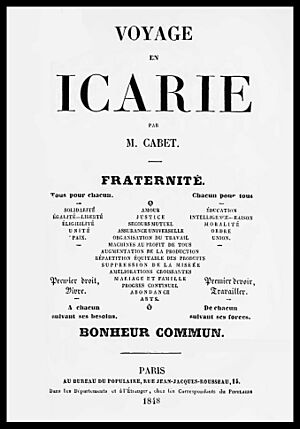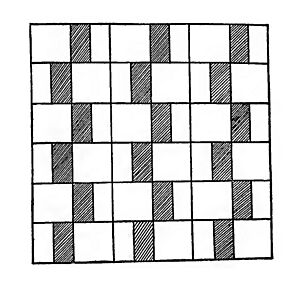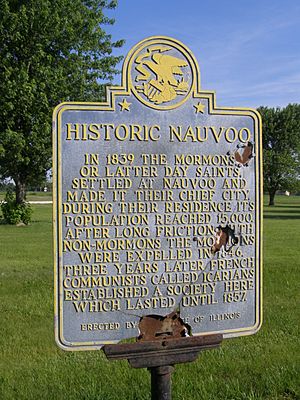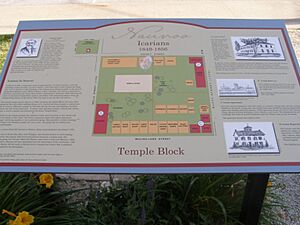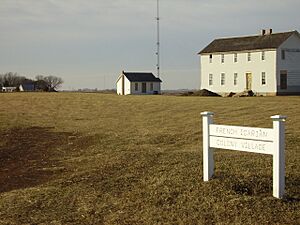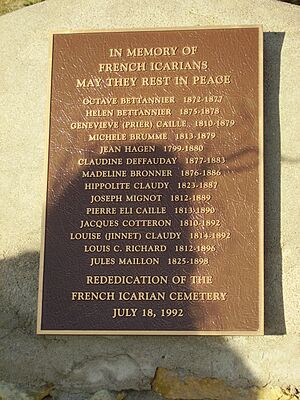Icarians facts for kids
The Icarians were a French group who believed in a perfect society. They followed the ideas of a politician and writer named Étienne Cabet. To try out his ideas about how society and money should work, Cabet led his followers to the United States in 1848.
In America, the Icarians set up several communities where everyone was treated equally. These communities were in Texas, Illinois, Iowa, Missouri, and California. The group often split because of disagreements among its members.
The very last Icarian community was near Corning, Iowa. It closed down on its own in 1898. This community lasted for 46 years, making it one of the longest-running non-religious shared living experiments in US history.
Contents
History of the Icarians
Étienne Cabet's Early Life and Ideas
Étienne Cabet was born in France in 1788. He came from a middle-class family. Cabet studied law and became a lawyer. However, he was more interested in politics and writing for newspapers. After Napoleon's rule ended in 1815, Cabet became active in groups that wanted a more democratic government.
In 1820, Cabet moved to Paris, the center of French politics. He joined secret groups that wanted change. After ten years, their efforts led to the Revolution of 1830. This revolution changed the government and brought back a constitutional system. Cabet was a key part of this revolution.
After the revolution, Cabet was given a job as Attorney-General for Corsica. But he soon started criticizing the new government for not being democratic enough. Because of this, he was removed from his job.
After losing his job, Cabet started writing. He wrote a history of the French Revolution. He also stayed active in politics and was elected to the National Assembly in 1834. Cabet strongly opposed the government. He was seen as a potential revolutionary leader. The government gave him a choice: two years in prison or five years in exile. He chose to leave the country and went to England.
During his five years in England, Cabet studied how political systems and money affected people's well-being throughout history. He realized that simply changing political rules wasn't enough to make society better. He saw that in every era, society was divided. A small group was rich and powerful, while a large group worked hard but had nothing.
Cabet wanted to change this. He wanted to find a way to stop one part of humanity from always being controlled by another. He started thinking about reorganizing society based on sharing everything. This idea was called "Communism" at the time. His ideas were similar to those of Robert Owen, whom he met in England.
Cabet's Book: Voyage en Icarie
In 1839, Cabet returned to France after his exile. He began writing a book to share his ideas about society and money. Like Thomas More's Utopia, Cabet wrote his book as a story. This allowed him to describe his ideal society and also subtly criticize the current government.
The book was first called Voyage et aventures de Lord William Carisdall en Icarie. It was published for friends in 1839 and for the public in 1840. A later edition in 1842 shortened the title to Voyage en Icarie.
The story is about a young English nobleman, Lord Carisdall, who discovers a hidden country called Icaria. He visits Icaria and writes about his amazing experiences. The first part of the book describes how wonderful life is in Icaria. Everyone works together, they have good education, high morals, and freedom. The second part explains that Icaria used to be like other countries. But in 1782, a hero named Icar led a revolution and created a system where everything was shared.
This part of the book allowed Cabet to criticize the problems of his own society. He also explained his ideas for how to change society. The last part of the book talked about the history of shared living ideas, from ancient times to the 1800s.
Even though some people today might find Cabet's book a bit boring, it was very popular in his time. Many saw it as a guide to a better future. Many editions of the book were quickly printed. Cabet soon moved from just writing to actually building a movement to put his ideas into practice. In 1841, he started a monthly magazine, Le Populaire, and an annual Icarian Almanac. These helped spread his ideas and organize his followers.
Many people in French cities supported "Icarianism." By the end of 1843, Cabet claimed 50,000 followers. These supporters began to see Cabet as a leader who could make their dreams come true. They wanted to create a real community based on his ideas. They decided that France was not the best place for this. Instead, they chose the United States. America had lots of cheap land and a democratic government, which seemed perfect for their new colony.
In May 1847, Cabet's magazine Le Populaire published an article called "Allons en Icarie" (Let Us Go to Icaria). It described the plan to build an American colony based on Icarian ideals. It asked for volunteers who wanted to build a community focused on farming and skilled crafts. This started the process of creating what they hoped would be a successful and admired shared community.
Starting the Colonies
Cabet believed that thousands of workers would immediately join the American colonization plan. He thought the number would quickly grow to a million skilled workers and craftspeople. He imagined towns and huge cities full of factories, schools, and cultural places. These would ensure a good life for everyone. People were excited about the plan. They offered to join and sent money, seeds, farm tools, clothes, books, and other useful items.
Cabet took on the job of choosing the exact location for the colony. He asked his friend Robert Owen for advice. In September 1847, Cabet traveled to London to talk with Owen. Owen suggested the new American state of Texas. He said Texas had huge amounts of empty land that was cheap and plentiful. Cabet contacted a Texas land agent, The Peters Company. They agreed to give Cabet a title for 1 million acres of land if it was settled by July 1, 1848.
Icarian Settlements
Texas: A Difficult Start
On February 3, 1848, a first group of 69 Icarians left France for Texas. They sailed on the ship Rome. They were supposed to go to New Orleans and then to their land in Texas, which they were told was near the Red River. This first group arrived in America on March 27, 1848.
They quickly found out they had been tricked. The land was 25 miles from the Red River. Also, the colony's lands were not connected. They were spread out like a checkerboard, with state and private lands in between. This made it impossible to live together as a community. Instead of 1 million acres, the contract only gave 320 acres to 3,125 individuals or families. Each family had to build a log cabin and live on their land by July 1, 1848. With only 69 people, they could not build more than about 30 cabins by the deadline. The promised 1 million acres turned into perhaps 10,000. By 1849, only 281 Icarians stayed loyal to Cabet and remained to rebuild. The rest went back to France.
The group could only travel by boat to Shreveport. They got a wagon and loaded it with supplies for a hard trip overland. The first group of 25 men left on April 8. Another 14 followed in a second wagon. Both wagons broke down along the way. The 39 Icarians had to walk in small groups, carrying what they could. They didn't reach their resting place until April 21. They were still more than a hundred difficult miles from their goal.
Only 27 brave French settlers made the final part of the trip to their new Texas community. This place was in today's Denton County (northwest of Dallas). The small group arrived on June 2, 1848. They immediately started working very hard to build homes to claim their land. They also tried to plow and farm the land. There was almost no time left to meet the land agreement terms. The hot summer sun dried up the ground. The Icarian colonists were poorly fed, poorly housed, overworked, and tired. Then, they got sick with cholera and malaria. Four people died, and the rest became ill. To make things worse, the only doctor in the group became mentally ill and left.
Back in France, the Revolution of 1848 was happening. The king had been overthrown. It seemed less urgent to move to America for democratic changes. So, fewer volunteers came for the Icarian colony. They had planned for about 1500 settlers in the next group. Only 19 made the trip, and barely half of them reached Texas to join the struggling first group.
The Texans realized how bad their situation was. They gave up on the Texas colony. The survivors split into small groups and made their way back to Shreveport, and then to New Orleans. Four more people died on the way. When they finally arrived in New Orleans late in 1848, they met several hundred people from France who were excited about the colony. Their mood was sad.
News of the Texas disaster reached Cabet in France. On December 13, 1848, he left Liverpool for America to try and save the project. After landing in New York, he sailed to New Orleans, arriving on January 19, 1849. Cabet found his supporters confused and discouraged, like a defeated army. Some wanted to give up and go back to France. Others wanted to continue the colony in a better place.
On January 21, the colonists held a meeting to decide what to do. Cabet said he would support them if most wanted to go back to France. But going back would mean losing all the money spent. A small majority of 280 people decided to continue the colony if they could find a better location. 200 wanted to return. The Icarians then formally split into two groups.
Money was taken from their funds to send the 200 unhappy Icarians back to France. Once back in France, many of them started legal actions against Cabet. They claimed he had tricked them. Cabet eventually had to return to France to answer these charges.
The majority, about 280 people, joined Cabet. They headed for Nauvoo, a town on the Mississippi River in Hancock County, Illinois. This is where the Icarian experiment truly began.
Nauvoo, Illinois: A New Beginning and a Split
Nauvoo was founded in 1839 by the Church of Jesus Christ of Latter Day Saints. By 1845, Nauvoo had grown to about 15,000 people. This was much larger than Chicago at the time. Most of the Latter-day Saints left in 1846 for Salt Lake City, Utah. They later sold their land to the Icarians in 1849.
Nauvoo became the first lasting Icarian Community. The Icarians immediately adopted the rules and structure described in Cabet's book, Voyage en Icarie. They had a president elected every year and officers for money, farming, industry, and education. New members had to live in the community for four months. Then, adult males voted to approve them. New members gave all their personal property to the community and promised $80. Visitors were welcome to stay as long as they wanted in a hotel.
Every family had the same amount of space: two rooms in an apartment building. They also had the same furniture. After age four, children lived in a boarding school separate from their parents. They visited their families only on Sundays. This was meant to help children love the community without showing too much special affection for their parents. This was thought to help the perfect society work smoothly. Sundays were not typical religious days. The Icarians did not practice a specific religion. But people would gather voluntarily in a fellowship called "Cours icarien" to discuss Cabet's writings and Christian morals.
Marriage was common and expected in the community. Divorce was allowed, but people were encouraged to remarry soon.
With basic housing settled, the community grew and did well for a short time. They rented farmland, opened a saw mill and a flour mill. They also set up workshops, schools, and a theater. They started publishing a newspaper in French, English, and German. An office was opened in Paris to find new members for the American colony. Life in Nauvoo was rich in culture. The Icarians held regular band concerts and theater shows. Their library had over 4,000 books in English and French. By 1855, more than 500 people were part of the Icarian project.
However, disagreements and personal issues led to the second major split of the Icarians in America. Étienne Cabet started in America in 1849 as the clear leader of the group. People freely gave him this power because his writings had inspired them. But this idea of one person having all the power went against the community's democratic ideals. Cabet himself realized this. In 1850, he suggested a constitution that would have an elected president and a board of directors. This would replace his own absolute power. This system worked well for a while.
In 1852, Cabet had to return to France for 18 months to deal with legal issues. When he came back to America, he started making many strict rules. These included banning talking in workshops and not allowing tobacco or alcohol. These rules were not popular with some members. He also tried to get back his personal power over the whole community. In December 1855, he suggested changing the constitution to have a powerful president elected for four years. This president, under Cabet's new plan, would control everything in the community.
Most Icarian members did not like Cabet's idea. They were strongly influenced by the democratic ideas of the French Revolution. However, Cabet strongly believed his position was needed to keep the community's morals strong. A strong group of his followers supported him.
The fight between the two groups continued for a year. It ended in a formal split. Cabet and about 170 of his followers were forced to leave Nauvoo in October 1856. They went downriver to St. Louis to start a new colony nearby.
The Nauvoo colony, which lost about 40% of its members, could no longer get money from France. It faced too many financial problems and had to close down in 1860. Many people from the Nauvoo colony later joined the Icarian colony in Iowa.
One part of the Icarian legacy still exists in Nauvoo. Emile and Annette Baxter joined the Icarian community in 1855. They stayed with it through the 1857 split. They remained in Nauvoo and started Baxter's Vineyards and Winery. It has been run by several generations of their family and is Illinois' oldest winery.
Cheltenham, Missouri: A Short-Lived Colony
The Icarians who left Nauvoo because they supported Cabet's personal leadership arrived in St. Louis on November 6, 1856. Sadly, Cabet, the leader they had split for, died just two days later. A 32-year-old lawyer named Benjamin Mercadier became the new leader.
On February 15, 1858, a group of 151 Icarians took over a few hundred acres in Cheltenham, St. Louis, Missouri. They used Cabet's money to pay $500 towards a $25,000 loan for 39 acres and three buildings. It was hard to adjust to a new area and new people. But the Icarians adopted a constitution, similar to the one in Nauvoo. They worked in the city and sent their children to local public schools. The colony quickly had many arguments. During the Civil War, many young men joined the Union army. By 1864, only about twenty people remained on the property. For others, diseases like dysentery and cholera spread in the warmer months. The Icarians could not make their loan payments. In March 1864, they returned the property keys, leaving a large debt. That same year, most members left the community, and the Cheltenham Icaria ended.
By 1872, the buildings were falling apart. In 1875, a fire destroyed the buildings, removing the last signs of the Icarian colony.
Corning, Iowa: The Longest-Lasting Community
In 1852, Icarians bought land in Adams County, Iowa to start a new permanent settlement. They began settling southwest of Queen City in 1853. In 1860, when the Nauvoo colony failed, many members moved to the new site in Iowa. The settlers arrived with only their skills and $20,000 in debt. Their land was about 4,000 acres. They first lived in mud huts and then in simple log cabins. The colony near what became Corning, Iowa was officially recognized by the state of Iowa in 1860. The community did well during the Civil War by selling food at good prices. They were able to pay off their debt by 1870.
In 1874, a journalist named Charles Nordhoff visited the Icarian colony near Corning. He was researching such communities for a book. Nordhoff found a two-story building that served as a dining hall, washhouse, and school. About a dozen simple wooden houses sheltered the colonists. At that time, there were about 65 members in 11 families. Most were French and spoke French. However, there was also an American, a Swiss, a Swede, a Spaniard, and two Germans.
Nordhoff wrote that the children looked very healthy and were well-dressed on Sundays. The food was simple. In the dining hall, they ate at tables without tablecloths. They drank from tin cups and poured water from tin cans. One colonist told him, "It is very plain, but we are independent — no man's servants — and we are content."
Nordhoff noted that the Iowa colony sold about 2,500 pounds of wool each year, as well as cattle, hogs, and products from their factories. The group continued to follow a detailed constitution written by Cabet. This constitution emphasized equality and brotherhood, sharing everything, and that the majority should rule.
The community was governed by weekly meetings of all adults on Saturdays. A President was elected every year as the formal head of the colony. But officers for running the meetings were elected each week. Besides the President, there were four elected directors in charge of farming, clothing, industry, and construction.
Nordhoff observed that the community had no formal religious services. Instead, "Sunday is a day of rest from labor, when the young men go out with guns, and the society sometimes has theatrical representations, or music, or some kind of amusement. The principle is to let each one do as he pleases."
In the 1870s, the Icarian colony near Corning had another split. The "vieux icariens" (old Icarians) were against allowing women to vote. But the "jeunes icariens" (young Icarians) were in favor. By a vote of 31 to 17, the community voted against women's right to vote. After that, the jeunes icariens moved to a new spot about a mile away on the same property. They moved eight wooden houses from the original colony. The vieux icariens community was no longer able to survive and had to close due to financial problems in 1878. The new community created a new constitution in 1879.
In 1898, this last community of Icarians decided to close down on its own. The members chose to join the nearby towns. Its 46 years of existence made the Corning Icarian community the longest-lasting non-religious shared living experiment in American history for a long time.
Today, you can find a historical exhibit about the Icarians in the Adams County hall in Corning. A living history site is also being rebuilt where the Icarians lived until 1898.
Quick facts for kids Icarians |
|
|---|---|
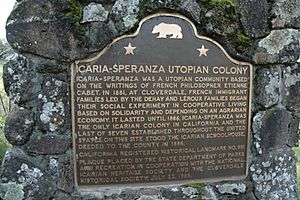
California Registered Historical Landmark No. 981: Icaria-Speranza Utopian Colony
|
|
| Location | Sonoma County |
| Official name: Icaria-Sperenza Commune | |
| Designated | November 22, 1988 |
| Reference no. | 835 |
Cloverdale, California: Icaria Speranza
A new colony called "Icaria Speranza" was started by Jules Leroux and Armand Dehay. In 1881, they moved from Jeune Icarie to an area just south of Cloverdale, California. The group bought an 885-acre ranch with vineyards, orchards, and farmland. It was first named Speranza, meaning "hope." Later, it gained members from Young Icaria and became Icaria-Speranza. At its largest, the settlement had about 55 people. This community closed down in 1886. Today, there is a historical marker south of town showing where their schoolhouse was.
How the Icarian Community Worked
Joining the Community
A set of rules created in 1853 said that people joining the Nauvoo colony had to give all their belongings to the community. They also had to give at least $60. Those who passed a four-month trial period could move to the permanent colony in Iowa.
Equality for All
The Icarians lived in shared dormitories that had central living and dining areas. All families lived in two equal rooms in an apartment building and had the same kind of furniture. Children were raised in a shared nursery, not just by their own parents. Jobs were divided among the group. For example, someone might be a seamstress and never need to cook.
Housing and Facilities
When the Icarians first arrived at Nauvoo on March 15, 1849, they bought several buildings, land, houses, cattle, and the burned-out Mormon Temple. They planned to use the temple as an academy or school.
After buying and fixing things, the Nauvoo Icarian village had apartments for families, two schools (one for girls and one for boys), two places for sick people, a pharmacy, a large community kitchen with a dining hall, a bakery, a butcher shop, and a laundry room. Soon after, they added a steam-powered flour mill, a distillery, a pigsty, and a sawmill. They also worked a local coal mine for fuel.
Work and Jobs
Work was divided by gender. Men worked as tailors, masons, wheel makers, shoemakers, mechanics, blacksmiths, carpenters, leather workers, and butchers. Women worked as cooks, seamstresses, laundry workers, and ironers.
To earn money, the Icarians traded with the outside world. They had a small store outside St. Louis. Here they sold their handmade shoes, boots, and dresses. They also sold items made by their mills and distillery.
Beliefs and Religion
The Icarians believed in a higher power. They had a ten-part principle that explained what they thought was needed for a perfect society.
Their beliefs included understanding:
- Evil and Misfortune
- Intelligence
- Causes of Evil
- God and Perfection
- Humanity's Destiny and Happiness
- Sociability (how people interact)
- Perfectibility (the ability to improve)
- The Remedy (for problems)
- God, Father of the Human Race
At eighteen years old, Icarians were taught about world religions. Marriage was strongly encouraged in the community. Divorce was allowed, but members were encouraged to remarry as soon as possible.
Cabet's book Vrai christianisme (True Christianity) was often read. It greatly influenced their religious ideas, though it wasn't a strict guide for religious services. In the Iowa colony, the Icarians had informal religious gatherings called "Cours Icariens" ("Icarian Course") on Sunday afternoons. Besides reading from Vrai christianisme and other books, these gatherings included quiet games and conversation.
Culture and Entertainment
Culture was very important in Icaria, second only to education. The community held concerts and theater shows for its members. They performed plays like "The Salamander" and "Six Heads in a Hat."
In Nauvoo, there was a library with over 4,000 books. It was the biggest library in Illinois at that time. The community also published a newspaper every two weeks called Colonie Icarienne.
The most important holidays were February 3, the anniversary of the first Icarians leaving France, and July 4, the summer festival. On July 4, the dining hall was decorated with flowers and branches. Signs said "Equality," "Freedom," and "Unity." Banners had quotes like "All for Each; Each for All" and "First Right is to Live; First Duty is to Work." They raised the American flag and played "The Star Spangled Banner" and "America." They traveled into Corning to watch the Fourth of July parade, but they stayed separate from the English-speaking Americans. At the end of the day, they returned to Icaria for a big meal, a dance, and a play. Icarians also celebrated Christmas, New Year's Day, and the Fete du Mais, a fall harvest corn festival similar to Thanksgiving.
Women's Rights
Men and women had equal chances to participate in weekly community meetings. They voted on who could join, changes to the constitution, and the election of the officer in charge of clothing and housing.
Works by Étienne Cabet
- Cabet, Étienne (1855) (in fr). Opinion icarienne sur le mariage: organisation icarienne, naturalisation. Paris: Auteur.
See also
 In Spanish: Icarianos para niños
In Spanish: Icarianos para niños




